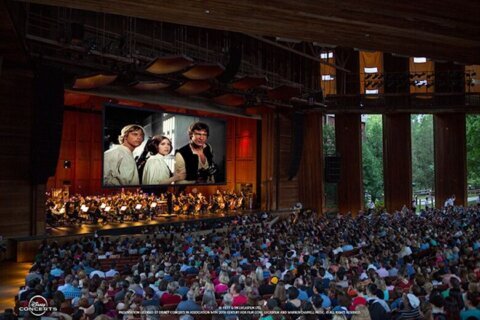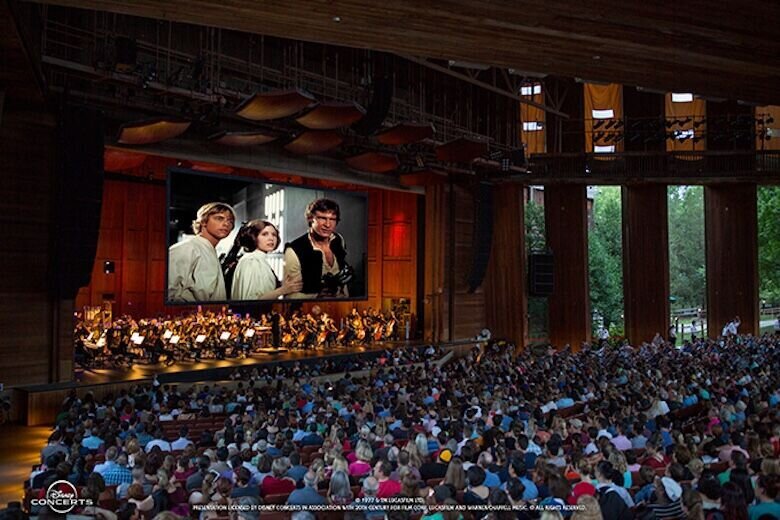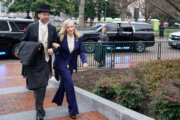Nothing beats watching a classic movie outdoors with live accompaniment by the National Symphony Orchestra.

This Saturday night, the NSO dazzles Wolf Trap with “Star Wars: Episode IV: A New Hope,” George Lucas’ original brainchild that brought us more iconic characters than any single film with Luke Skywalker, Darth Vader, Princess Leia, Han Solo, Chewbacca, C-3PO, R2-D2 and Obi-Wan Kenobi.
“These films were never meant to be a multibillion-dollar franchise,” conductor Emil de Cou told WTOP. “Before it had the ‘New Hope’ title, it was just supposed to be a one-off film. If you look at it, it has a beginning, middle and end. They conquer the bad guys and the finish could be the end of the whole thing, then of course it went on to great sequels and everything. But when you watch it, just try to imagine that this is separate, this is by itself.”
Before the performance, join National Air and Space Museum curator Margaret A. Weitekamp on the Farmhouse Lawn (to the left of the main gate) at 7 p.m. for a preshow talk about the franchise’s wide-ranging influence.
“In a beautiful national park like Wolf Trap, you’re there with the trees and the birds and the smells; you can bring wine, you can bring snacks,” de Cou said. “People are always so excited about ‘Star Wars,’ you always see people dressed in costumes from the show and there’s always Stormtroopers, it’s like a real event.”
At 8 p.m., audiences will head into the Filene Center to watch the classic feature film projected in high-definition on giant screens both in-house and on the lawn, all accompanied by the music of a live symphony orchestra.
“You get the greatest sound system in the world with the National Symphony Orchestra,” de Cou said. “You have screens facing the lawn and above the orchestra, bigger than any IMAX screen, it’s absolutely massive. You are able to hear the music the way that John Williams imagined it in his head and how he heard it in the studio when they recorded it … to hear the first ‘Star Wars’ film with an 85-piece orchestra playing all out.”
The music won composer John Williams his third of five career Oscars for Best Original Score.
“An amazing, totally inspired score, one of the greatest things ever put on paper,” de Cou said. “John Williams writes this like a Wagner opera. … This was the height of a genre of space operas where it’s a story told on such a huge canvas, that has violence, love and all these epic things that you’d find in any great opera of the 19th century, but it’s turned into a science-fiction opera. John Williams is the first composer to treat the music that way.”
It starts with the title bursting on screen to kick off the scrolling prologue text.
“It starts and you get the Fox fanfare with the famous logo and everything, then you get a pause … then that one chord in B-flat-major, the way he scores it, everybody knows what it is, it’s the opening of ‘Star Wars,'” de Cou said. “You get these words on the screen as big as can be and the audience always erupts and goes insane. It’s so thrilling. You couldn’t have a better opening to a concert than the audience screaming to the opening chord.”
You’ll also hear the wailing Jedi theme as Luke Skywalker gazes out at a double sunset.
“That is a great scene because he’s with his uncle and aunt, who have raised him,” de Cou said. “He doesn’t want to be a farmer like his uncle … but he really has this burning desire to go out for an adventure. He goes out and looks at this double (sun) in this bleak, but beautiful, planet and you hear the very first iterations of ‘Theme of the Force’ or ‘Obi-Wan Kenobi’s Theme.’ It’s a minor key and it’s very mournful sounding, but it’s also very inspiring.”
One of the most underrated pieces remains the ethereal “Princess Leia’s Theme.”
“This theme presents Princess Leia as a character because in the other two films, it becomes both her theme and a love theme between her and Han Solo,” de Cou said. “It’s usually high woodwinds like flute, oboe or clarinet playing in a very tender, quiet way. He’ll bring it back later during the fight scenes when she’s doing something heroic, you’ll hear her theme thrown into this big wash of tumult, then it goes back to something else.”
Ironically, the “Imperial March” didn’t arrive until the sequel “The Empire Strikes Back” (1980).
“Darth Vader doesn’t have a theme yet, but it’s always a unison note in a menacing, minor key,” de Cou said. “You get Darth Vader’s theme in the next film, (but here) you get the same marshal rhythm that’s very sinister and evil.”
Add it all up and you get the greatest movie score ever written, according to the American Film Institute.
“I’ve conducted this several times and I’ve spent maybe 50 hours just in the past two months with this movie — the score is very marked up with ink everywhere — and when I get to the end, I’m just in awe,” de Cou said. “Sometimes the hair on my arms goes up. … It never loses the initial power that he wrote in 1977. It just gets better.”
Listen to our full conversation here.
Get breaking news and daily headlines delivered to your email inbox by signing up here.
© 2024 WTOP. All Rights Reserved. This website is not intended for users located within the European Economic Area.







